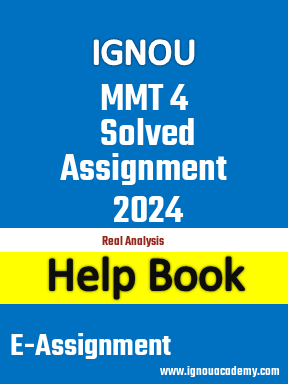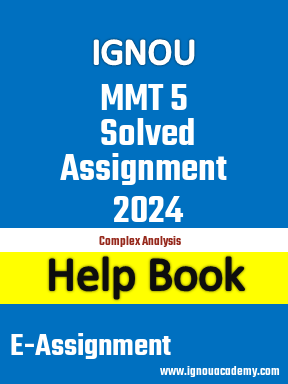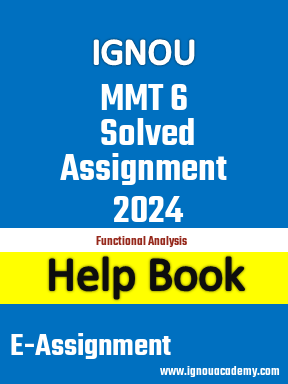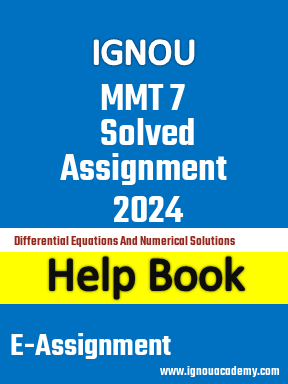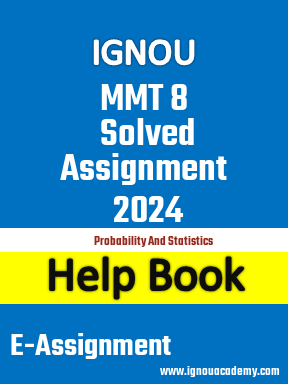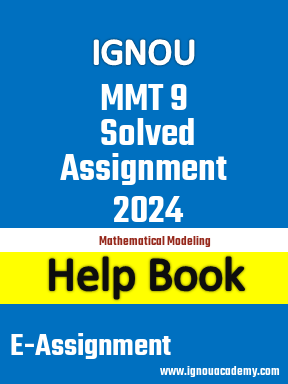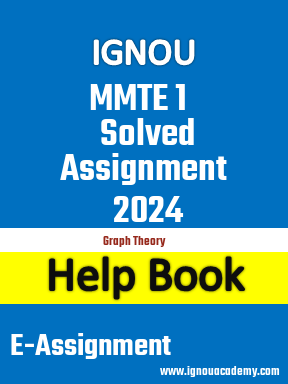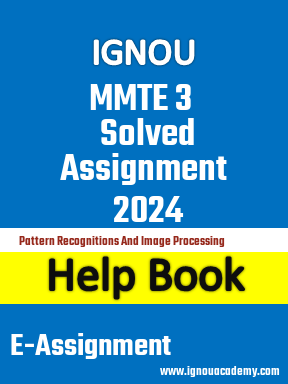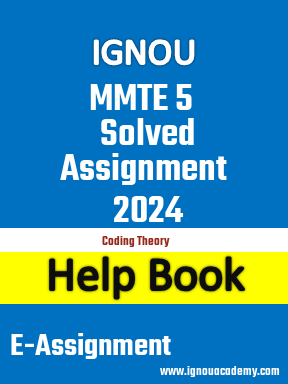My Cart
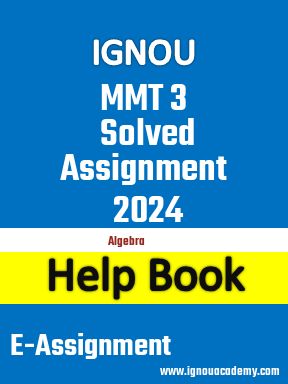
|
|
IGNOU MMT 3 Algebra Solved Assignment 2024
IGNOU MMT 3 Algebra Solved Assignment 2024|
|
| Title Name | IGNOU MMT 3 Algebra Solved Assignment 2024 |
|---|---|
| Type | Soft Copy (E-Assignment) .pdf |
| University | IGNOU |
| Degree | MASTER DEGREE PROGRAMMES |
| Course Code | MSCMACS |
| Course Name | M.Sc. Mathematics with Applications in Computer Science |
| Subject Code | MMT 3 |
| Subject Name | Algebra |
| Year | 2024 |
| Session | - |
| Language | English Medium |
| Assignment Code | MMT-03/Assignmentt-1//2024 |
| Product Description | Assignment of MSCMACS (M.Sc. Mathematics with Applications in Computer Science) 2024. Latest MMT 03 2024 Solved Assignment Solutions |
| Last Date of IGNOU Assignment Submission | Last Date of Submission of IGNOU MMT-03 (MSCMACS) 2024 Assignment is for January 2024 Session: 30th September, 2024 (for December 2024 Term End Exam). Semester Wise January 2024 Session: 30th March, 2024 (for June 2024 Term End Exam). July 2024 Session: 30th September, 2024 (for December 2024 Term End Exam). |
| Assignment Code | MMT 3/2024 |
|
|
Questions Included in this Help Book
Ques 1.
Which of the following statements are true and which are false? Give reasons for your answer.
(a) If a finite group G acts on a finite set ?, then for all
.
(b) There are exactly 8 elements of order 3 in .
(c) If , then
.
(d) .
(e) For any
Ques 2.
Consider the natural action of on
, the set of
real matrices, by left multiplication.
(i) Under this action, if , show that the stabiliser of
is {I}, where I is the 2 × 2 identity matrix.
(ii) Suppose that det(x) = 0 in the remaining parts of this exercise. We will show that the stabiliser of x is infinite. If x = 0, the stabiliser of x is . So suppose x ≠ 0. Let us write
. Then,
for non-zero
. Why ?
(iii) Let be a vector that is not a scalar multiple of
. Show that there is a matrix
such that
and
.(Hint: Set up two sets of simultaneous equations in two unknowns and argue why they have a solution.)
(iv) Check that I−b is in the stabiliser of x. Also, show that there are infinitely many choices of for which I − b is invertible.
Ques 3.
Let H be a finite group and, for some prime p, let P be a p-Sylow subgroup of H which is normal in H. Suppose H is normal in K, where K is a finite group. Then, show that P is normal in K
Ques 4.
Find the elementary divisors and invariant factors of .
Ques 5.
Describe the set of primes p for which splits into linear factors over
Ques 6.
Determine, up to isomorphism, all the finite groups with exactly 2 conjugacy classes
Ques 7.
Is there a finite group with class equation 1 + 1 + 2 + 2 + 2 + 2 + 2 + 2?
Ques 8.
Compute the following:
a).
b).
Ques 9.
Let be a finite extension F of odd degree(greater than 1). Show that
Ques 10.
Let and let
be algebraic over F of degree m and n, respectively. Show that
. What can you say about
, if m and n are coprime?
Ques 11.
Find where
Ques 12.
If , show that a polynomial
is irreducible iff
where
is the group of squares in
.
Ques 13.
By looking at the factorisation of guess the number of irreducible polynomials of degree 2 over
. Find all the irreducible polynomials of degree 2 over
.
Ques 14.
If F is a finite field show that there is always an irreducible polynomial of the form where
.(Hint: Show that
is not a surjective map.)
Ques 15.
Suppose that is
matrix where A,B,C and D are
matrices. Show that M is symplectic if and only if the following conditions are satisfied:
(Hint: Use block matrix multiplication.) Also, check that the matrix , where A is a
orthogonal matrix, is a symplectic matrix.
Ques 16.
The aim of this exercise is to show that SP2(R)acts transitively on R2 \ {0}.
Ques 17.
Show that a matrix is symplectic if and only if ad - bc = 1
Ques 18.
Show that, to prove that SP2(R) acts transitively on GL2(R), it is enough to show that, for any vector , there is a
symplectic matrix with
as the first column. (Hint: For any matrix A, what is
?)
Ques 19.
Complete the proof by showing that, given any non-zero vector , there is always a non-zero vector
such that
is symplectic.
Ques 20.
In this exercise, we ask you to find the Sylow p-subgroups of the dihedral group
(a) Let p be an odd prime that divides n, . Suppose
. Show that C is the unique Sylow p-subgroup of Dn .
(b) Prove the relation
Further, find all the elements of order 2 in Dn .
(c) Find all the Sylow 2-subgroups of Dn when n is odd. Describe them in terms of x and y.
(d) Suppose n is even, n = 2km, where . Let
and
. Show that HN is a subgroup of Dn . What is its order?
(e) Suppose n is as in the previous part. Find all the Sylow 2-supgroups of Dn . Describe them in terms of x and y.
Ques 21.
Let . Show that G is the cyclic group of order six.
Ques 22.
Solve the following set of congruences:
Ques 23.
Show that is not a UFD by giving two different factorisations of 20
|
|
Related Assignments
IGNOU Doubts & Queries
Click to Contact Us
Call - 9199852182 Call - 9852900088 myabhasolutions@gmail.com WhatsApp - 9852900088

